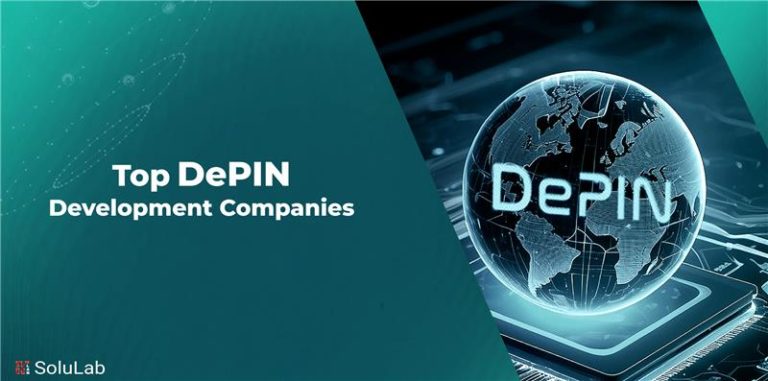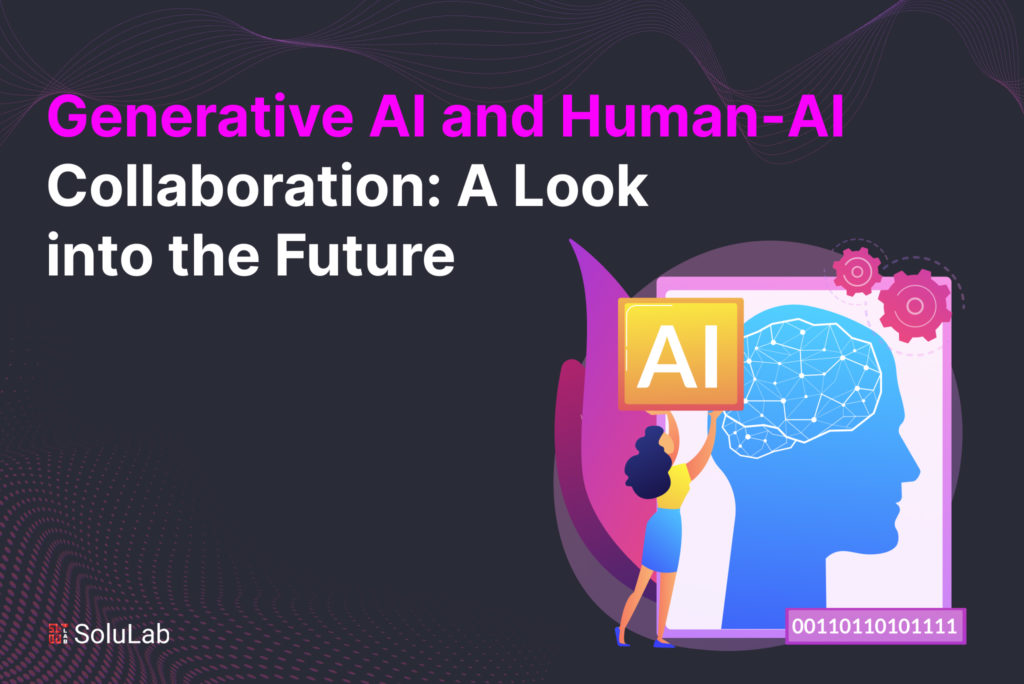
Generative Artificial Intelligence (AI), often referred to as Generative AI, is a cutting-edge branch of artificial intelligence that revolves around the creation of autonomous systems capable of producing content that is original, creative, and indistinguishable from human-generated output. Unlike traditional AI models, which primarily focus on data analysis and pattern recognition, Generative AI seeks to simulate human creativity and generate content autonomously, such as text, images, music, and even entire narratives.
Generative AI leverages deep learning techniques, including neural networks such as Generative Adversarial Networks (GANs) and Transformers, to understand patterns, styles, and contexts from vast datasets. This understanding allows it to generate content that is contextually relevant, coherent, and, in many cases, aesthetically pleasing. Whether it’s generating realistic images from textual descriptions or composing coherent and context-aware text, Generative AI holds immense potential to reshape various industries and human-machine interactions.
This blog intends to shed light on the revolutionary influence of generative artificial intelligence, how it is positioned to revolutionize numerous sectors, and the ways in which it might enhance human skills. Additionally, it emphasizes the necessity for the ethical and responsible integration of AI technology into our daily lives while exploring the collaboration possibilities of humans and AI.
Read Our Blog Post: Exploring the Current State of Generative AI: An In-Depth Analysis
How Does Generative AI Contribute to the Collaboration Between Humans and AI?
The journey of AI development has been a remarkable odyssey marked by ingenuity, persistence, and the pursuit of emulating human intelligence. The roots of AI can be traced back to ancient civilizations, where myths and legends often featured artificial beings, embodying mankind’s fascination with creating intelligent life. However, the modern era of AI development took shape in the mid-20th century.
In the 1950s and 1960s, the foundational concepts of AI were established, including symbolic reasoning and problem-solving. Pioneers like Alan Turing and John McCarthy laid the groundwork for AI by proposing theories and developing early computer programs that demonstrated machine learning capabilities.
What are the Key Advancements in AI Technology Over the Years?
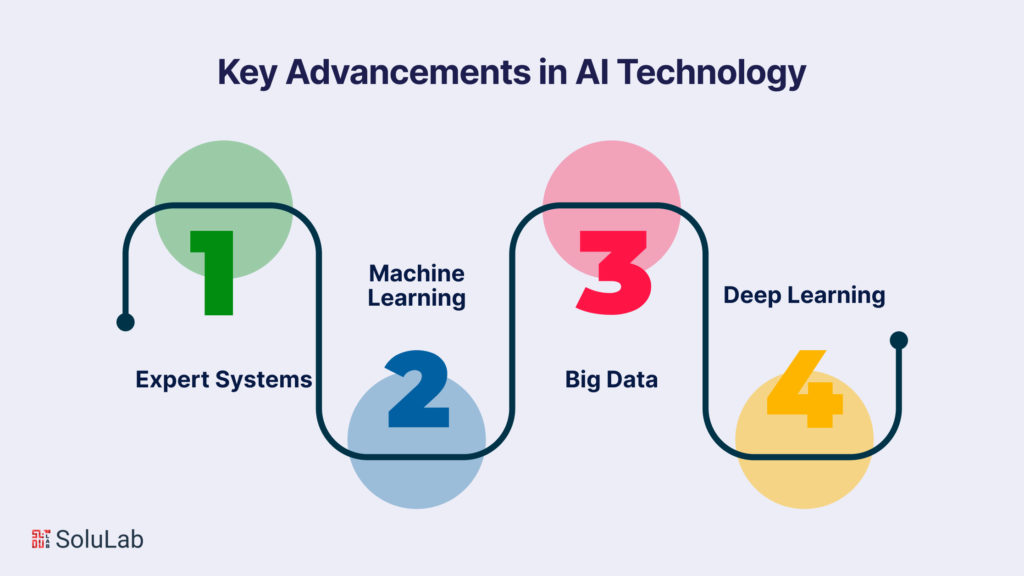
The journey of AI development has been a remarkable odyssey marked by ingenuity, persistence, and the pursuit of emulating human intelligence. The roots of AI can be traced back to ancient civilizations, where myths and legends often featured artificial beings, embodying mankind’s fascination with creating intelligent life. However, the modern era of AI development took shape in the mid-20th century.
In the 1950s and 1960s, the foundational concepts of AI were established, including symbolic reasoning and problem-solving. Pioneers like Alan Turing and John McCarthy laid the groundwork for AI by proposing theories and developing early computer programs that demonstrated machine learning capabilities.
Advancements in AI Technology
Advancements in AI technology have been nothing short of revolutionary, particularly in the past few decades. The evolution of AI can be categorized into several key phases:
-
Expert Systems
In the 1970s and 1980s, AI development saw the rise of expert systems, and rule-based programs that could simulate human expertise in specific domains. This era marked the first practical applications of AI in fields like medicine and finance.
-
Machine Learning
The late 20th century saw a shift toward machine learning approaches, where AI systems learned from data. Techniques such as neural networks and decision trees emerged, enabling AI to make predictions and classify data with increasing accuracy.
-
Big Data
The advent of big data in the 21st century provided AI with massive datasets to train on. This led to breakthroughs in natural language processing, computer vision, and recommendation systems, transforming industries like e-commerce, healthcare, and entertainment.
-
Deep Learning
Deep learning, characterized by deep neural networks, emerged as a dominant AI paradigm. This technology powered significant advancements in image recognition, speech synthesis, and autonomous vehicles.
What is the Role of Generative AI in AI Development?
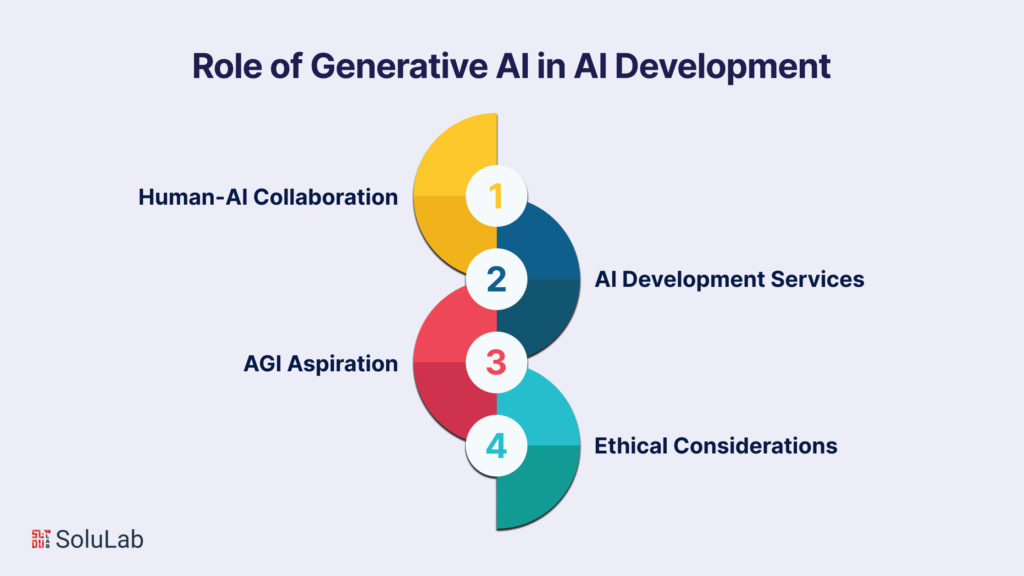
Generative AI stands at the forefront of AI development, playing a pivotal role in shaping the future of human-AI collaboration and the quest for artificial general intelligence (AGI). Generative AI encompasses a wide range of generative AI models, including Generative Adversarial Networks (GANs) and Transformers, which have revolutionized content generation and manipulation.
1. Human-AI Collaboration
Generative AI fosters collaboration between humans and machines by augmenting human creativity and productivity. It enables artists, writers, and designers to generate novel content, while also assisting professionals in tasks like data augmentation and content generation.
2. AI Development Services
The growth of Generative AI has spurred the emergence of specialized AI development services. Companies and organizations can now leverage these services to harness the power of Generative AI in their projects, further accelerating AI development across industries.
3. AGI Aspiration
Generative AI plays a crucial role in the pursuit of artificial general intelligence. Its ability to generate coherent and context-aware content brings us closer to creating AI systems that can understand and perform tasks across diverse domains, ultimately blurring the lines between AI and human intelligence.
4. Ethical Considerations
The rapid development of Generative AI also raises ethical concerns, particularly in terms of content manipulation and potential misuse. Thus, as the Generative AI landscape continues to evolve, ethical frameworks and responsible practices must be integral to AI development.
What are the Benefits of Collaboration Between Humans and AI?
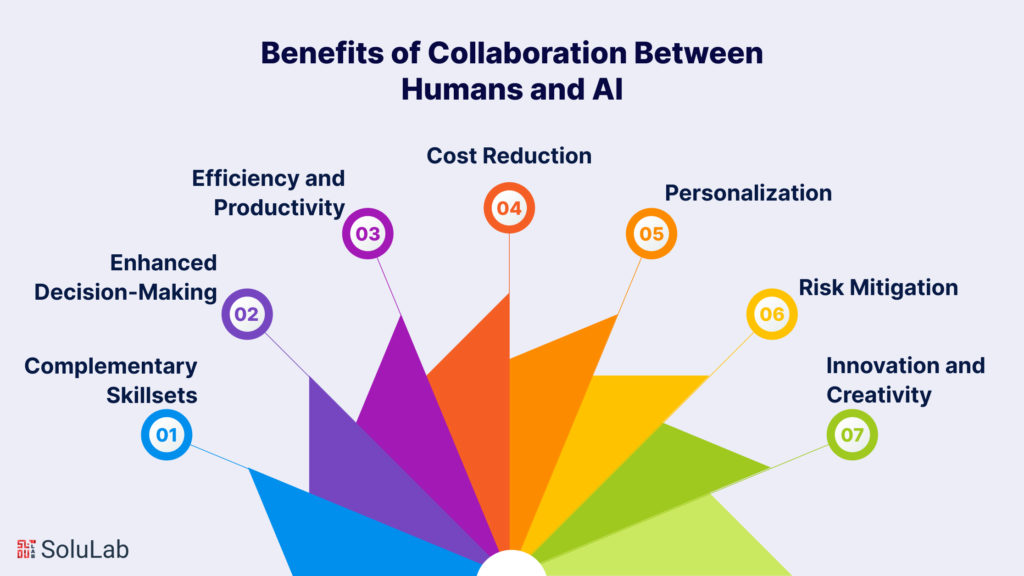
Collaboration between humans and AI, often referred to as human-AI collaboration, offers a multitude of benefits and advantages in the field of AI development and its real-world applications. Here’s a detailed exploration of these advantages:
-
Complementary Skillsets
Collaborative artificial intelligence leverages the strengths of both humans and AI. While humans excel in creativity, emotional intelligence, and contextual understanding, AI systems possess rapid data processing capabilities, precision, and scalability. Together, they can complement each other’s skill sets.
-
Enhanced Decision-Making
In various industries such as healthcare, finance, and cybersecurity, human-AI collaboration results in improved decision-making. AI can process vast amounts of data quickly, providing insights that humans might miss. Humans, on the other hand, can add critical judgment and ethical considerations to AI-generated recommendations.
-
Efficiency and Productivity
AI can automate repetitive and time-consuming tasks, freeing up human workers to focus on more complex and creative aspects of their jobs. This leads to increased efficiency and productivity in the workplace.
-
Cost Reduction
Integrating AI into processes can significantly reduce operational costs. AI-powered chatbots, for example, can handle customer queries 24/7, reducing the need for round-the-clock human customer support.
-
Personalization
Human-AI collaboration enables businesses to offer personalized experiences to their customers. AI algorithms can analyze user data and preferences to provide tailored recommendations, while humans can ensure that these recommendations align with brand values.
-
Risk Mitigation
In industries like aviation and healthcare, the collaboration between humans and AI helps in risk mitigation. Pilots and doctors, for instance, can rely on AI systems for real-time data analysis and diagnosis, reducing the chances of human errors.
-
Innovation and Creativity
AI can assist humans in creative tasks, such as content generation, art creation, and product design. Generative AI tools empower artists and designers by providing new perspectives and ideas.
What are the Real-World Applications of Human-AI Collaboration?
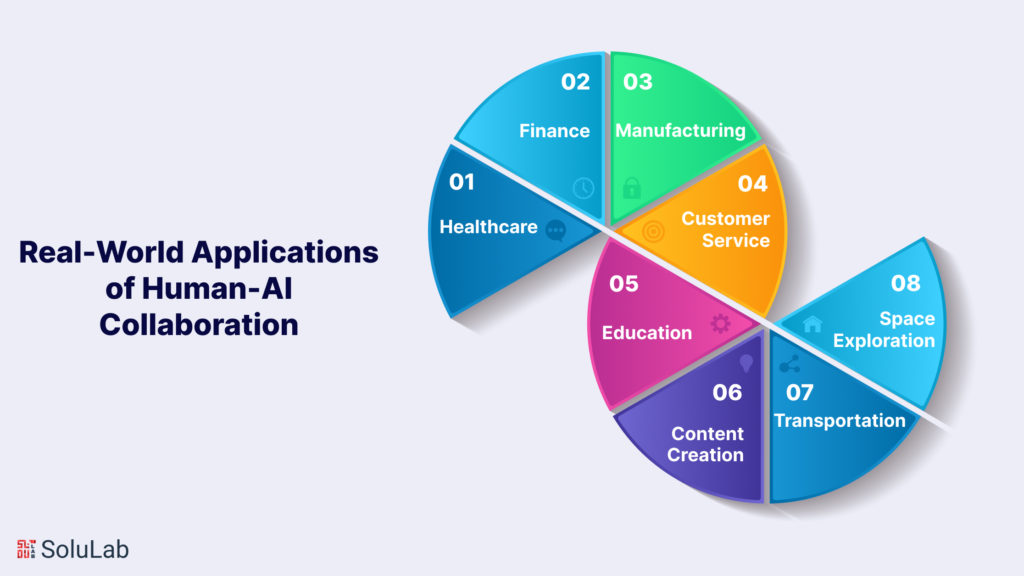
Human-AI collaboration has rapidly emerged as a transformative force across various industries, revolutionizing the way we approach problem-solving, decision-making, and innovation. The fusion of human expertise with the capabilities of AI development services and Generative AI tools has led to remarkable real-world applications. Here, we explore some of these applications:
1. Healthcare
-
Diagnostic Assistance
Human-AI collaboration aids healthcare professionals in diagnosing diseases more accurately. AI algorithms analyze medical images, such as X-rays and MRIs, and highlight potential issues for doctors to review.
-
Drug Discovery
AI systems process vast datasets to identify potential drug candidates, expediting the drug development process and enhancing the discovery of novel treatments.
2. Finance
-
Algorithmic Trading
Financial institutions use AI-powered algorithms to make split-second trading decisions, maximizing returns and minimizing risks.
-
Customer Service
Chatbots and virtual assistants handle customer inquiries, streamline account management, and offer financial advice, improving customer service efficiency.
Read Our Case Study: Generative AI in Banking and Finance
3. Manufacturing
-
Collaborative Robotics
Collaborative artificial intelligence robots (cobots) work alongside human workers on factory floors, automating repetitive tasks and ensuring precision in manufacturing processes.
-
Predictive Maintenance
AI predicts when machinery in manufacturing plants requires maintenance, reducing downtime and improving overall equipment efficiency.
4. Customer Service
-
Personalized Support
AI-driven systems analyze customer data to provide personalized recommendations and assistance, enhancing customer satisfaction.
-
Language Translation
AI-powered language translation tools enable businesses to communicate effectively with global customers and partners.
5. Education
-
Personalized Learning
AI in education adapts educational content to individual students’ abilities and learning styles, improving engagement and learning outcomes.
-
AI Tutors
AI tutors assist students in understanding complex topics and provide instant feedback on assignments and quizzes.
6. Content Creation
-
Text Generation
Generative AI tools generate high-quality written content for marketing, journalism, and creative writing.
-
Art and Design
AI-powered tools assist artists and designers in generating visual content and creative concepts.
7. Transportation
-
Autonomous Vehicles
Self-driving cars and trucks utilize AI to navigate roads, enhancing safety and potentially reducing traffic congestion.
-
Traffic Management
AI systems optimize traffic flow in smart cities, reducing commute times and improving transportation efficiency.
Related: The impact of AI in Transportation
8. Space Exploration
-
Data Analysis
AI processes and analyzes data from space missions, aiding scientists in discovering new insights about our universe.
-
Robotics
AI-powered robots are deployed on celestial bodies to conduct experiments and gather data.
How Will Human-AI Collaboration Change in the Future?
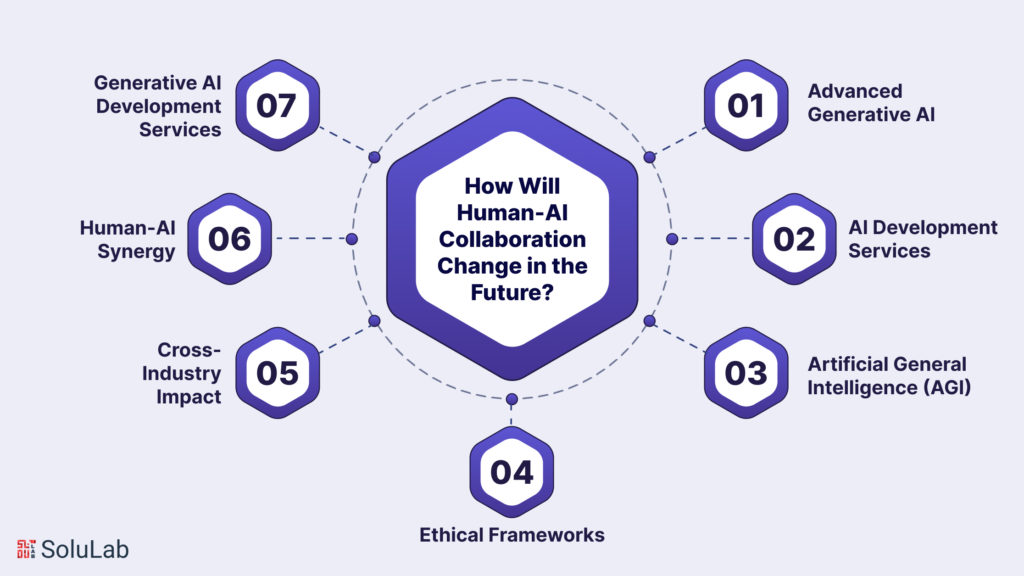
The future of AI development and collaboration between humans and AI systems holds immense promise and transformative potential. As we look ahead, several Generative AI trends are poised to shape the landscape of Human-AI collaboration:
-
Advanced Generative AI
Generative AI tools will continue to evolve, enabling machines to create content with even greater sophistication. These AI systems will be able to generate high-quality text, images, videos, and music, revolutionizing content creation and artistic endeavors.
-
AI Development Services
The demand for AI development services will surge, driven by businesses seeking to harness the power of AI for automation, optimization, and innovation. AI development companies will play a crucial role in providing tailored solutions across industries.
-
Artificial General Intelligence (AGI)
While AGI remains a long-term goal, we can expect progress toward systems with broader problem-solving capabilities. AGI could revolutionize fields like healthcare, finance, and research, where complex decision-making is crucial.
-
Ethical Frameworks
Ethical considerations in Collaborative artificial intelligence will gain prominence. The development of responsible AI, privacy safeguards, and AI transparency will be key areas of focus to ensure that AI benefits society without causing harm.
-
Cross-Industry Impact
AI will continue to permeate various industries, including healthcare, finance, manufacturing, and education. In healthcare, AI-powered diagnostics and personalized treatments will improve patient outcomes. In finance, AI will enhance fraud detection and investment strategies.
-
Human-AI Synergy
Rather than replacing human jobs, AI will increasingly augment human capabilities. Collaborative artificial intelligence robots and AI assistants will become commonplace in workplaces, helping humans perform tasks more efficiently.
-
Generative AI Development Services
SoluLab is at the forefront of providing cutting-edge Generative AI development services that empower businesses to harness the full potential of AI-driven generative technologies. As a trusted partner in AI development solutions, SoluLab offers a comprehensive suite of services that cater to diverse industry needs, ensuring innovation, efficiency, and competitiveness.
Ethical Considerations in Human-AI Collaboration
The growth of Human-AI collaboration brings forth critical ethical considerations:
-
Bias Mitigation
Ethical AI development will prioritize the mitigation of biases in AI algorithms, ensuring fair and unbiased decision-making across diverse populations.
-
Data Privacy
Protecting individuals’ data privacy will remain paramount. Stricter regulations and robust data protection mechanisms will be implemented to safeguard user information.
-
Transparency
AI systems must be transparent, providing explanations for their decisions. This transparency is crucial for accountability and user trust.
-
Accountability
Establishing clear lines of accountability for AI systems’ actions will be essential. When AI is involved in critical decisions, responsibility must be clearly defined.
-
Job Displacement
Addressing the potential displacement of jobs due to automation, retraining programs, and policies to support affected workers will be crucial.
Potential Impact of Human-AI Collaboration on Various Industries
The impact of Human-AI collaboration will vary across industries:
-
Healthcare
AI will accelerate drug discovery, enhance diagnostics, and personalize treatment plans, improving patient outcomes and reducing healthcare costs.
-
Finance
AI will enhance risk assessment, fraud detection, and investment strategies, making financial systems more efficient and secure.
-
Manufacturing
Smart factories powered by AI will optimize production processes, leading to increased productivity and reduced waste.
Check Out Our Blog: Generative AI in Manufacturing – Benefits and Use Cases
-
Education
AI-driven personalized learning platforms will cater to individual student needs, improving educational outcomes.
-
Entertainment
Generative AI will transform content creation, enabling the production of highly customized and engaging media.
-
Transportation
Self-driving vehicles and AI-optimized traffic management will improve road safety and reduce congestion.
Conclusion
In conclusion, the future of AI development and human-artificial intelligence collaboration holds immense promise, and SoluLab stands at the forefront of this transformative journey.
With its expertise in Generative AI and a dedicated team of Generative AI developers, SoluLab is well-equipped to lead the way in harnessing the potential of generative AI tools. The synergy between Generative AI and Human collaboration not only paves the path towards achieving artificial general intelligence but also fosters a future where AI augments and complements human intelligence.
SoluLab’s commitment to providing top-notch Generative AI development services reaffirms their dedication to empowering businesses and industries with cutting-edge AI solutions. As we embark on this exciting journey into the future, SoluLab’s role as a trailblazer in the realm of Generative AI and human-AI collaboration is pivotal.
So, if you’re looking to unlock the full potential of Generative AI, there’s no better choice than to hire the top Generative AI developers at SoluLab. Together, we can shape a world where the fusion of AI and human intelligence leads to unprecedented advancements and possibilities. Connect with SoluLab today to embark on this transformative journey.
FAQs
1. What is Generative AI, and how does it relate to Human-AI Collaboration?
Generative AI is a subset of artificial intelligence development that focuses on creating systems capable of generating content, such as text, images, or music, autonomously. Human-AI collaboration refers to the synergy between human intelligence and AI technologies. In the future, Generative AI will play a crucial role in enhancing this collaboration by assisting and augmenting human creativity and productivity.
2. How can Generative AI tools benefit the Development of Artificial Intelligence?
Generative AI tools can streamline the AI development process by automating the generation of code, data, and even design elements. They can assist AI developers in creating models, generating datasets, and optimizing algorithms, making the entire AI development cycle more efficient and productive.
3. What are the potential applications of Generative AI and Human-AI Collaboration?
The applications are vast, ranging from content generation, data analysis, and creative arts to scientific research, healthcare, and autonomous systems. Human-AI collaboration can bring about groundbreaking innovations and efficiencies across various industries.
4. Can Generative AI contribute to the development of artificial general intelligence (AGI)?
Yes, Generative AI plays a role in AGI development. It aids in creating more capable and versatile AI systems, which is a step towards achieving artificial general intelligence. Human-AI collaboration will be instrumental in advancing AGI research.
5. How can I find Generative AI development services or hire top Generative AI developers?
You can find Generative AI development services and hire skilled developers through AI development agencies, freelance platforms, or by reaching out to AI research institutions. Ensure that you assess the expertise, portfolio, and experience of developers or service providers to meet your specific project needs.
6. Are there any ethical concerns related to Generative AI and Human-AI Collaboration?
Yes, ethical concerns such as bias in AI-generated content, job displacement, and privacy issues must be addressed. Human-AI collaboration requires careful consideration of ethical guidelines and regulations to ensure responsible and fair AI development and usage.






